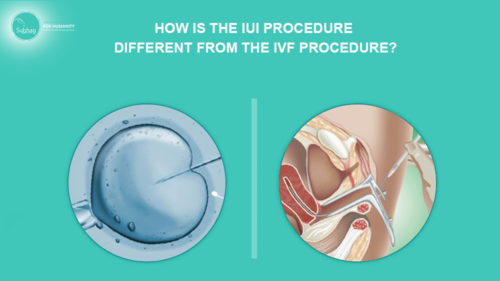If you’re thinking of doing your first IUI procedure, this blog will tell you what you need to know before your procedure and highlight the IUI process day by day. Many couples face difficulties when deciding on the best infertility treatment, and they have many questions, ranging from how it works to how successful IUI is! When drugs fail to produce a natural form of pregnancy, doctors prescribe IUI (intrauterine insemination) and IVF (in-vitro fertilization) as artificial infertility treatments.
While technology has advanced by leaps and bounds, the basic phenomena have remained the same, and the IUI process day by day as you will notice it, is still considered the best infertility treatment for helping women conceive.
Understanding The IUI Procedure?
Intrauterine insemination (IUI) is one of the most straightforward ways of assisted reproduction, with the goal of increasing the amount of sperm that enter the uterus and fertilize the egg on its own.
Intrauterine insemination, or IUI, is a relatively simple fertility procedure. It can be carried out with or without the use of fertility drugs. The process includes inserting washed and concentrated sperm directly into the uterus through a thin catheter. IUI is used to improve the probability of pregnancy at the time of ovulation or in combination with fertility drugs.
In contrast to in vitro fertilization, this method of fertility treatment is less invasive and less expensive.
Let us understand in brief the first IUI process day by day. This procedure starts with a baseline pregnancy test and ultrasound within the first few days of your menstrual cycle.
You’ll go to the doctor’s office two to three times during your period to help them time the IUI with when you’ll be ovulating. Ultrasounds and blood tests will be used by your doctor to track your estrogen levels, uterine lining, and egg (follicle) formation. If your cycle is longer than normal, you may need to return for another appointment. The IUI will be performed on your final visit, which is normally the fourth.
How Is The IUI Procedure Different From The IVF Procedure?

Fertility methods such as intrauterine insemination (IUI) and in vitro fertilization (IVF) with intracytoplasmic sperm injection (ICSI) are used to assist people who are having trouble conceiving.
The key distinction between IUI and IVF methods is that IVF involves egg stimulation, extraction, fertilization, and transfer, while an IUI involves injecting sperm into a uterus to shorten the sperm’s travel to the egg.
Both of these methods fall under the umbrella of assisted reproductive techniques (ART), specifically assisted reproductive technology (ART), which offers a range of treatments to help individuals and couples achieve pregnancy.
When you first start the procedure, people are usually confused about the differences between an IUI and an IVF treatment, and the medical jargon for fertility treatments can a learning curve. Since learning the acronyms can be confusing, we’ll break down IUI and IVF to help you understand the differences between the two fertility procedures.
The IVF Procedure Is A Five-step Treatment That Involves The Following:
- Diagnostic tests prior to the start of the cycle.
- Stimulation of the ovaries to produce a sufficient number of eggs in a single cycle.
- The extraction of eggs from each ovary.
- Fertilization of the eggs in the lab via traditional fertilization or ICSI.
- Transferring the embryo into the uterus.
The likelihood of a successful IVF pregnancy is highly dependent on the woman’s age, the primary cause of infertility, and some factors related to the IVF laboratory’s efficiency.
IUI, on the other hand, is a fertility procedure in which sperm is directly injected into a woman’s uterus during ovulation, shortening the sperm’s path to the egg. The woman releases one egg during ovulation, which is picked up by the end of the fallopian tube, where it awaits the sperm. Also, IUI plants higher concentrations of good quality sperm near where the egg is waiting, raising the likelihood of the sperm fertilizing the egg.
Which Treatment Is More Suitable For You, IUI Or IVF?
IUI, or artificial insemination, is the most common fertility procedure, as previously mentioned. Apart from the fact that it is often the first procedure that many people try, it is less invasive and fertilization occurs internally rather than in a lab. Artificial insemination, as a result, necessitates functioning ovaries, viable eggs, and fallopian tubes, as well as the availability of 5-10 motile sperm after the male partner’s ejaculate, is processed in the reproductive tract.
If you or your partner do not meet the criteria for IUI, IVF may be an option. IVF is used to treat a variety of infertility issues, including uterine complications, tubal issues, endometriosis, age-related infertility, low sperm count and/or motility, unexplained infertility, erectile dysfunction, and more. IVF is also a good option for those who choose to use donor eggs or a surrogate.
What Kind Of Infertility Factors Is IUI Treatment The Most Effective On?
Infertility care with intrauterine insemination is effective for infertile couples, single mothers, couples of the same gender, and in the following cases:
- Couples that are having fertility problems or are experiencing unexplained infertility.
- Couples that are having fertility problems or are experiencing unexplained infertility.
- Couples of the same gender who do not have fertility problems but want a child.
- Couples who are unable to have sexual intercourse because they may be suffering from physical conditions, injuries, or premature ejaculations in the male partner.
- Couples with medical conditions, such as HIV, in which an HIV-positive patient may pass the disease on to their partner or unborn child.
- If the male partner is allergic to sperm.
The best quality of prepared sperm is isolated and then inserted into the uterus of the women during IUI treatment. The sperm fertilizes the egg naturally after that.
Thus, by now you might have understood what is the best option for you. IUI or IVF? If the answer is IUI, then stick around because now we will discuss the IUI process day by day and what you will be going through if you chose this procedure and how you will be experiencing the IUI process day by day.
Medicated IUI Vs Unmedicated IUI
In the first step of the IUI process day by day guide, you will have to determine if you need to opt for a medicated IUI procedure or an unmedicated IUI procedure.
Your physician can prescribe a prescription to stimulate ovulation based on your particular health condition, age, and the reasons for the insemination. To stimulate ovulation, you’ll usually take the drug for around five days during your cycle. Some women take a daily prescription for about 14 days before ovulation occurs, despite the fact that it is less normal.
You may prefer an unmedicated IUI if you have no trouble ovulating on your own or if you are having an IUI for non-medical reasons—for example, because you are single or in a same-sex relationship. Your doctor may prescribe an over-the-counter ovulation kit to help time the insemination in this case.
There is a risk of occurrence of multiples from a variety of drugs. However, medication is often required to increase the chances of pregnancy, particularly when a couple has been trying to conceive for 12 to 18 months before visiting a fertility clinic.
In fact, in over a third of infertility cases, the problem is with the man, making it necessary to consider medication to boost the number of eggs available in order to increase the chances of pregnancy, as recommended by the American Society for Reproductive Medicine (ASRM).
Prepping For Your IUI
This is the step in your IUI process day by day guide where you will be getting ready for your procedure.
You’ll need to do some testing before the treatment to make sure IUI is the correct choice for you.
This is the same testing method that women who are undergoing IVF will undergo, and it will help your doctor better understand your fertility needs.
Blood testing, including a hormone levels blood test, will be conducted to search for hormones that control the ovarian reserve, as well as genetic blood work to see whether you’re a carrier for any diseases.
Additionally, your doctor may also conduct a sperm production test to assess the health and quantity of sperm in your partner’s semen, along with other additional tests such as a scrotal ultrasound. These tests will help determine the best course of action for your IUI procedure.
Prepping for your IUI may involve scheduling and preparing for these important blood tests with your health care provider.
The sperm you’ll use – whether from a donor or your partner – will be screened, and you’ll have a hysterosalpingogram (HSG) to make sure your fallopian tubes are open and ready for sperm to move through. You’ll be scheduled for an IUI if everything looks good.
You should avoid sex for two to three days prior to the operation. During ovulation is the perfect time for an IUI procedure. If you aren’t ovulating on a regular basis, your doctor can prescribe an ovulation inducer. Check with your doctor to see if there are any other relevant guidelines for your treatment.
IUI normally requires women to have their ovaries stimulated to mature eggs and to take a trigger shot to release one egg. The sperm must then be prepared, and only then will the insemination take place.
This phase of stimulation can take up to ten days. Women who opt out of stimulation before IUI simply follow their natural cycle, take an ovulation-inducing injection and then get the IUI performed.
IUI Preparation Of Male Sperm
The next step in the IUI process day by day guide is prepping the male sperm.
The male partner of a couple undergoing intrauterine insemination will either have freshly ejaculated sperm at the time of the operation or a sample that has been frozen and thawed. If donor sperm is used, it is frozen and processed at the clinic before being used in an IUI operation.
Masturbation is the most common method of sperm collection, although an electrical stimulator or a special collection condom used to collect sperm during intercourse can also be used. The best sample is obtained when the male partner goes two or three days without ejaculating before supplying the sample.
This raises sperm count, which leads to a rise in pregnancy rates and accurate results. For those who choose to collect a sample during intercourse, a special condom can be used to collect semen and must be quickly brought to a medical setting for analysis.
Sperm Washing
Next, in the IUI process day by day, once the sperm is collected, it has to be readied through a method called sperm washing to be inserted into the uterus of the female partner.
Sperm is washed, concentrated, and warmed in a laboratory for an IUI procedure. Sperm washing improves the chances of fertilization by eliminating mucus and non-motile sperm from the sperm. The woman may feel pain and cramping during the procedure if the sperm are not washed.
Options For Donor Sperm
If the male partner does not have sufficiently motile sperm or has a genetic disorder, or if the woman does not have a male partner, as in single moms or gay couples, donor sperm is used as an option for male fertility problems.
In rare cases, when treatment does not work, frozen sperm samples from donors that have been screened for transmissible diseases and genetic abnormalities are available from reputable sperm banks, and fertility testing can be done to confirm the viability of the sperm.
The sperm bank obtains donated sperm samples, which are then frozen. If sperm is donated by a friend or family member, it must be quarantined for six months before being used.
At the time of selection, the identified donor is screened for sexually transmitted diseases, sperm quality, and sperm concentration through semen tests, and then again after six months of storage. After that, the sperm can be used for donor insemination.
IUI Timing
This is the step in the IUI process day by day guide where the timing of the IUI has to be decided in such a way that it will have the highest chances of success after the procedure.
The egg has a fertilization window of 12 to 24 hours after ovulation. Sperm must arrive in the fallopian tube when the egg is present for IUI to be successful. Furthermore, sperm prepared for IUI treatment does not last as long as sperm introduced during intercourse, so IUI sperm will not have as much time to fertilize an egg as sperm introduced during intercourse. As a result, the time period in which the operation is performed, specifically considering sperm movement, is important.
The IUI Procedure
This is the step of the IUI process day by day guide where the actual procedure takes place.
The doctor will inject the semen into the uterus until the egg has been released and is ready for fertilization. The cervix mucus is cleared away, and a small catheter is inserted into the uterine canal using a vaginal speculum. The catheter is extracted after the sperm cells are slowly implanted.
Although some women can experience brief, mild cramping, the procedure is relatively simple and painless. In most cases, an IUI takes just a few minutes to complete, after which the woman can rest for 15 minutes on the table.
Complications After IUI

Since you learned what will happen in the IUI process day by day, you should also be aware of what kind of complications can accompany this procedure.
Though this procedure is considered one of the simplest and least complicated fertility treatments, there still are some complications that may or may not arrive after the procedure.
There is a risk of some complications in this infertility procedure since it is a normal method of placing prepared sperm into the uterus of the woman.
Toxic infections in the uterus or fallopian tubes, as well as bacterial transmission during the transfer of semen samples and sperm analysis to multiple pregnancies, are among the complications that can be detected through abnormal results and possible causes.
As a result, steps should be taken ahead of time, and these types of procedures should only be carried out after consulting a doctor and in a reputable clinic that prioritizes hygiene and proper use of birth control. Furthermore, multiple pregnancies will result in severe health problems since unborn children are at risk of being born prematurely.
Pregnancy Symptoms After The Procedure
Worry not, we won’t abandon you as soon as your procedure is done. We know that the main part is the pregnancy after the procedure, when will it occur and what are symptoms you should be looking for.
Thus, in the final step of the IUI process day by day guide, we will tell you what are the symptoms after the procedure that you should be on the lookout for, to detect your pregnancy.
The medical start of a pregnancy is marked by implantation. Since implantation allows the body to begin releasing HCG, the pregnancy hormone that pregnancy tests measure, it is difficult to get a positive pregnancy test before implantation. It is unlikely to experience pregnancy symptoms before implantation because HCG development starts only at implantation and you are not pregnant before implantation.
Symptoms usually don’t appear until several days after implantation, when HCG levels start to rapidly increase. And some women don’t show any signs of pregnancy until after they’ve had a positive pregnancy test. So don’t let the lack of symptoms dampen your spirits.
Pregnancy symptoms can be mild at first. They resemble the signals of when the period is approaching for many women. As a result, keeping track of your symptoms over time will help you better understand your body’s cycles. The most obvious indication that you may be pregnant is a deviation from the normal.
The following are the most common early pregnancy symptoms:
- Constipation.
- Discomforts in the stomach, such as diarrhea or stomach pain.
- Nausea, dizziness, or vomiting are common symptoms.
- Tenderness in the breasts
- Exhaustion
These symptoms appear to become more intense as HCG levels increase. You would, however, have been able to obtain a positive pregnancy test by that point. The fact is that most women don’t experience early pregnancy signs for several weeks, so don’t expect your body to tell you you’re pregnant right away. A missed period is often the first sign of pregnancy for most women.
Therefore, this concludes our IUI process day by day guide. Hope that this helps you on your IUI journey and that you can achieve your dream of having a kid with the help of an IUI procedure.





